Power (Tubes) To the People: A Survey of 4 Sets of Tubes in 2 Push-Pull Amps
by Steve Graham
Regarding the picture above; No, I didn’t power-up with one of each installed and yes, I had four of each of the above tubes for the shootout.
I did say after my 6DJ8 (part 1, 2) tube shootout, that I didn’t want to do another one soon.. but here I am, this time with power tubes. There won’t be any unobtainable NOS tease-tubes this time, just current production.
The inspiration for this test was the fun I had building and listening to the Elekit TU-8340VK (review part 1, 2). I did a little bit of casual tube rolling during the review, but settled on Electro-Harmonix 6550 output tubes as decent, not expensive, all-rounders. A raid of my box of 12AT7s yielded a quad of new production Tung-Sols, spares for my phono stage, which worked very well. Though not the least expensive 12AT7’s available, the Tung-Sols are not outrageously priced. The Elekit TU-8340VK I built and reviewed contained the resistor upgrade package and the less expensive of the two Mundorf coupling capacitor upgrades.
Good-guy Jon at Thetubestore.com kindly loaned me the Genalex Gold Lion KT77 and Tung-Sol KT120 tubes. A troll of my own tubes netted the Electro-Harmonix EL34’s and 6550’s.
The other amps used in this shootout were a pair of Parks Audio Eiclone monoblocks. These are a freely-interpreted rethink of a classic Eico design from the 1960’s. Unlike the originals, these have fixed (adjustable) bias, so just about any tube can be adjusted to run at its optimum. For a refresher, see the brief description of bias about half way through part one of my Elekit TU-8340VK review.
The Eiclone is a standard fixed bias design, where the user must adjust the voltage (a not dangerous ~1 volt) on each output tube, while monitoring with an inexpensive multimeter. I say not dangerous (electrically), but the circuit board is laid out with the bias adjustment almost between the two power tubes. I wore a glove on my left hand to prevent it getting singed while holding the multimeter probe. The advantage of the manual bias adjustment is that, power supply and output transformer permitting, almost any tube from 6L6GC’s to KT150’s can be biased for optimum operation.
System Particulars
My usual system consists of Cambridge 840C CD player, PSB Platinum T8 speakers and PS Audio Power Plant Premier AC conditioner. My ARC amplification pair was given a holiday. All of this was connected up with a motley array of DIY power cables, interconnects and speaker cables – my motley crew. I also still had the kind loan of the Triangle Antal XS speakers, that I’ll describe more completely in the TU-8340VK follow up coming soon. Both the Elekit and the Eiclones were driven by my ‘Jane’ Aikido linestage, that worked very well for the TU-8340VK review. See part two of the TU-8340VK review for those details.
The usual proviso about tube sound being dependant on the equipment it’s being used in, applies doubly so with power tubes. If, like with my Eiclones, bias can be adjusted to optimize operation, then in theory any tube can be used. However, electrical characteristics do vary between tube part numbers, i.e. EL34 versus 6550. When coupled through the impedance of the output transformer these differences might result in sub-optimal speaker matching. This coupling is more crucial when using moderate efficiency, low impedance speakers, like my 4 ohm PSB’s. For this reason I decided to do most of my listening tests with the more efficient, 6 ohm Triangles even though their tilted-up high frequency output can be problematic. I think the Triangles are a more representative pairing, budget, size and efficiency-wise, than my top of the line (in their day) PSB’s. I gave the various tubes a quick listen with my PSB’s towards the end of the shootout sessions.
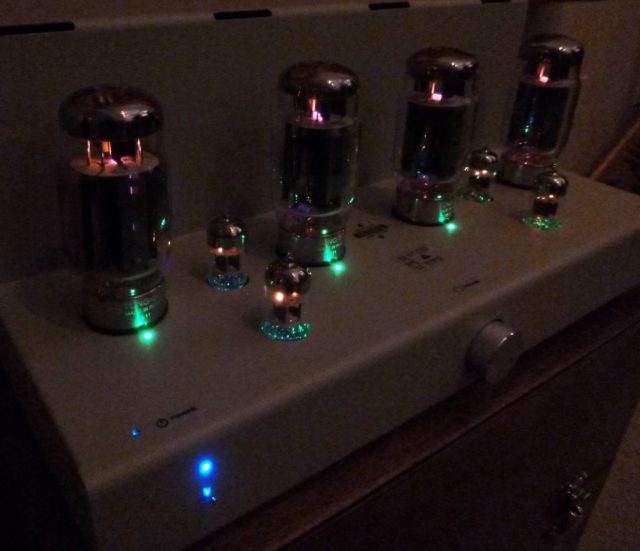
In this instance it’s hard to rank the tubes with a numerical score. For a start, performance is much more nuanced than a simple number can describe. Besides, my brain hurts too much if I have to conjure up a number. Preferences are very subjective, and system variables are, well, variable. It’s a bit like asking the question, “Which is the loveliest model in the SI swimsuit issue?” Answer: “All of them.” The best I can offer is my honest impressions with two power amplifiers and two pairs of speakers.
A Tale of Two Bias Settings
Before I get to the tubes there is something we need to consider about the Semi Auto Bias Module in the Elekit TU-8340VK. The module doesn’t “know” is if it’s adjusting the bias on a 6L6, 6550, KT150 or any other tube. Therefore, the module’s bias set point must be configured such that the dissipation limit of the lowest-power tube that’s likely to be installed, will not be exceeded. This will be the 6L6GC, EL34 or KT77, depending on the plate voltage a particular amp is running. Low and medium power dissipation tubes are likely to be run in the more linear part of their range whereas the higher powered tubes, KT120’s and especially KT150’s, might not be quite getting the “juice” they need to sound their best. This might be why Victor Kung of VKmusic.ca, the Elekit distributor in North America, likes the sound of the amp when used with tubes from the lower power end of the spectrum, EL34’s in particular. I’ll get into the nuts and bolts of this a bit more in the upcoming TU-8340VK follow up, where I’ll also do some triode-mode listening.
As mentioned above, my Eiclone can be adjusted to suit the specific bias needs of virtually any tube. I obtained the data sheets for all of the tubes under test from the New Sensor website and extracted the maximum power dissipation for each. I then calculated the dissipated power that the Elekit TU-8340VK semiauto bias module will set based on the voltage chart, other circuit parameters and component values in the amp assembly manual.
I prefer to bias output tubes somewhere near 75% of their safe dissipation limit to maximize sound quality. Higher than this they’ll be overly stressed and useful life will most likely be shortened. Too low and sound quality, in my experience, is reduced. To further explore this I listened to the tubes in my Eiclone biased at around 75% of their dissipation limit. If the power dissipation as biased by the Elekit was significantly different, I adjusted the Eiclone bias to mimic the Elekit level and listened again. If this sounds confusing, it should become clear when reading the individual tube reviews below.
Distortion at very low bias can be quite easy to hear with fixed bias amps. Just crank the bias back to the lowest setting and start playing a track. Gradually turn up the bias while listening. It’s sometimes possible to do this with the TU-8340VK as well. Pause a track or set the volume control to minimum. Press the safety reset button, which lowers the bias, then set the track playing again.
Favourite Tubes
You’ll note I didn’t say best tubes. Best is a matter of taste, my favourite is my best. Your favourite, therefore your best, might be different. What I’m looking for is balanced performance. I like bass to be deep but controlled too, though I’ll gladly trade off a bit of depth for better control. Midrange should be clear and expressive but not at the expense of all else, especially bass depth and/or treble detail. I find good high frequency performance the most elusive. To me the high frequencies show up deficiencies in recording and production technique. Compression, poor digital conversion and mixes that are just too “hot” conspire against us audiophiles. I want high frequency detail but not at the cost of listener fatigue.
Generally speaking the Eiclone and Elekit are not vastly different in their sonic perspectives. The Eiclone digs a bit deeper in the bass, not surprising with their twice-as-large output transformers. Conversely the Elekit is a bit more nuanced and extended at the high frequency end of the spectrum – especially so with the Mundorf capacitor upgrade.
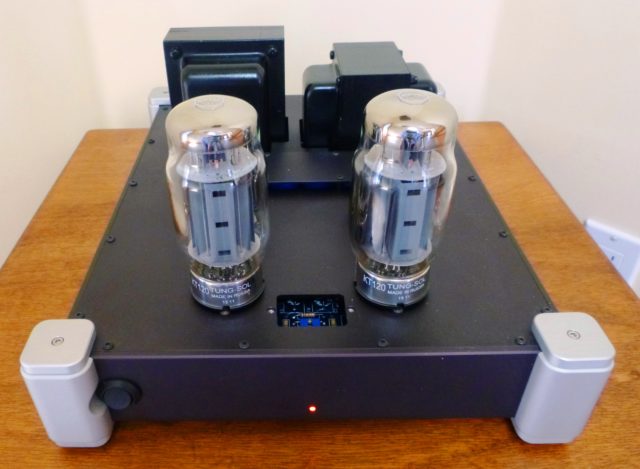
Brief summary for you impatient types
(you’ll have to scroll to the end for the full summary)
Eiclone Amp, Triangle Speakers. My favourite tube: Tung-Sol KT120
With the bias cranked to 11 this combination is the real deal. The more efficient Triangles had a seeming effortlessness to them with this much power available. See comments immediately below for PSB speakers, they apply to this combination as well. Actually it’s a close contest between the KT120 and KT77 with this amp/speaker. The Genalex Gold Lion KT77 comes in a close second.
Eiclone Amp, PSB Speakers. My favourite tube: Tung-Sol KT120
With the bias cranked to 11 this combination was the closest I’ve ever heard any linestage/amp/tube get to my ARC duo driving the PSBs. This, for my listening tastes, is the magic tube for this amp/speaker combination.
Elekit Amp, Triangle Speakers. My favourite tube: Genalex Gold Lion KT77
The Aikido/Elekit/KT77 combination got darn close to the Aikido/Eiclone/KT120 combo described above, but in some respects I think it was slightly better. There just seemed to be a bit more natural, yet slightly clearer quality, especially in the upper mids and high frequencies. The KT77 is, for my listening tastes, the magic tube for this amp/speaker combination.
Elekit Amp, PSB Speakers. My favourite tube: Genalex Gold Lion KT77
With the Aikido/Elekit/KT77, the mids and highs were nicely rendered but the bass was obviously trying harder and didn’t quite have the ease of the Aikido/Eiclone/KT120 combo described above. This is my favourite tube with this amp/speaker combo, and though not the most ideal combination, the KT77 made the best of it.
Rating the Tubes
At one point in the process of evaluating all of these combinations, I was feeling like I’d gotten lost in a labyrinth. I couldn’t remember my point of departure, which had been the sound of my ARC components with the PSB speakers. To cleanse my audio pallet, so to speak, so I went back to the ARC Ref 3, Ref 110 and PSB setup. The performance of all of the tube/amp/speaker combinations just seemed to snap into focus and I could proceed with ranking their performance.
The following evaluations of the individual tubes are an amalgam of listening to both the Triangle and PSB speakers. The Triangles are a bit more lively, the PSB’s a bit more buttoned down. The Triangles sound more “hi-fi” in that they grab your attention, but their bright treble can fatigue at times.
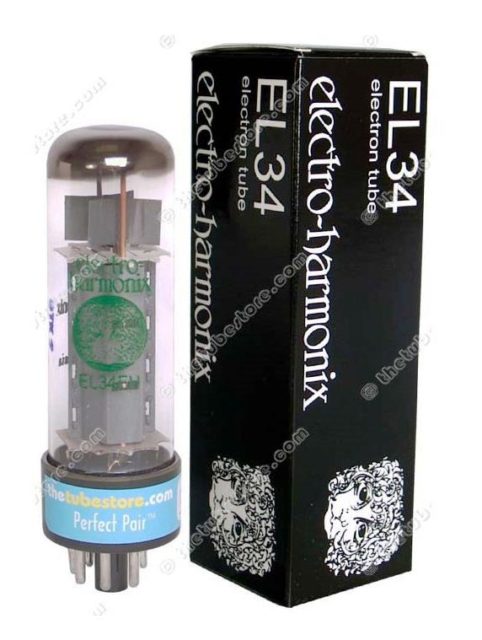 Electro-Harmonix EL34 ~$27 CDN each from Thetubestore.com
Electro-Harmonix EL34 ~$27 CDN each from Thetubestore.com
I dissed this tube a bit in the Elekit TU-8340VK review. Now that I’ve had another chance to listen, I find them fairly likeable. Not my favourite, but likeable in the right circumstances.
Eiclone Amp. Bias set to 83% of dissipation limit. These tubes at this setting do nice things with vocals, especially female ones. Bass is slightly less deep compared to 66% but it is better controlled. Highs are reasonably airy with a bit more detail compared to 66%.
Eiclone Amp. Bias set to 66% of dissipation limit (like Elekit). Midrange is not as good as, nor quite as “special” as this tube is at 83%. Bass is reasonably deep but not as controlled as at 83%. The highs seem softer and less defined as too.
Elekit Amp. Bias automatically set to 66% of dissipation limit. Performance sort of straddles that of the two Eiclone settings but is closer to the 83% one. Bass performance is closer to the 83% setting. Mids are closer to that setting as well but not quite as “special”. The highs are a bit brighter but this I think is partially down to the nature of the Elekit with the Mundorf caps.
None of the amp/EL34 combos delivered the bass grip and extension I crave. Not my favourite tube but OK especially in view of their low price. Recommend if you are in to vocal and/or chamber music. Not enough romp and stomp for me though.
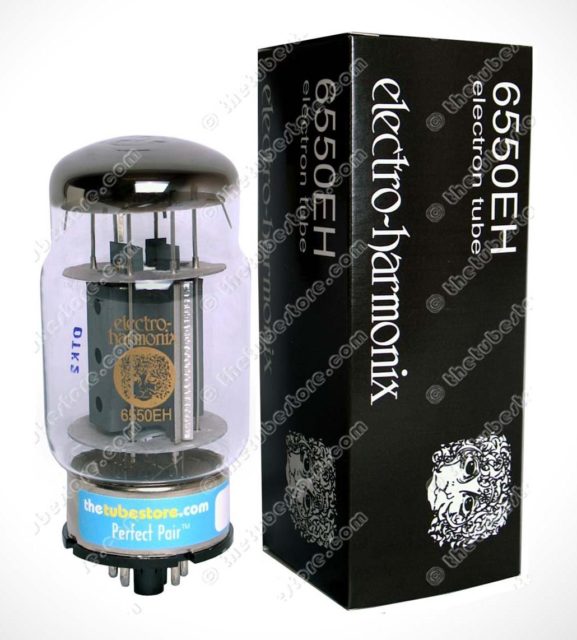 Electro-Harmonix 6550 ~$51 CDN each from Thetubestore.com
Electro-Harmonix 6550 ~$51 CDN each from Thetubestore.com
Eiclone Amp. Bias set to 71% of dissipation limit. Bass is reasonably deep and well controlled. The midrange is clear but not quite as “special” as the EL34 at 83% dissipation. The highs are a bit too bright for my tastes with both speakers but especially so with the Triangles.
Eiclone Amp. Bias set to 45% of dissipation limit (like Elekit). Bass and treble are reduced in comparison to this tube at 71%. The highs are still a bit too bright for my liking. The tube sounds a bit dynamically constrained compared to 71% bias.
Elekit Amp. Bias automatically set to 45% of dissipation limit. Performance is sort of between the two Eiclones. Bass performance is closer to the 71% setting. Mids are closer to the 71% setting as well but not quite as good. The highs are a bit brighter than either Eiclone setting, this primarily down to amp differences I suspect.
The E-H 6550 has great get-up-and-boogie factor, especially at the higher bias setting in the Eiclone. They are not the most refined sounding tubes of the ones surveyed here, but the fun quotient is higher than I found with the E-H EL34. The bass was more extended, they’re more dynamic and generally more engaging too. For nearly twice the cost of the E-H EL34, they ought to offer more; the mids of the EL34 – especially with a high bias setting in the Eiclone – were “nicer”. Most of my listening in part 2 of the TU-8340VK review was done with these tubes. They don’t cost big bucks as power tubes go.
Recommended if your speakers don’t have tilted up highs like the Triangles do.
 Genalex Gold Lion KT77 (reissue) on loan from Thetubestore.com ~$67 CDN each
Genalex Gold Lion KT77 (reissue) on loan from Thetubestore.com ~$67 CDN each
Tim Smith favourably reviewed these tubes a little over a year ago in a couple of single ended amps, but I wanted to hear them doing push-pull duty.
Though this statement might give tube purists fits, this modern KT77 is, in my estimation, a variant of the EL34 family of tubes. But are these worth 2½ times the ticket price of an E-H EL34?
Eiclone Amp. Bias set to 75% of dissipation limit. Deeper bass but a smidge less well controlled compared to the E-H 6550. The KT77 goes almost as deep as KT120 but with a bit less control. The midrange is clear but not quite as “special” as the EL34 at 83% dissipation in the Eiclone. The highs are a bit brighter than the KT120’s but less bright than the E-H 6550. This might not sound like a ringing endorsement but the sound was very balanced and enjoyable overall.
Elekit Amp. Bias automatically set to 70% of dissipation limit. All of the things I said above about the KT77 in the Eiclone apply here, but even more so. Music seemed to have a bit more natural flow in the Elekit. The highs were a bit brighter but did not offend because the bass performance was deep and well controlled. There was also better defined placement of voices and instruments in the sound stage compared to these tubes in the Eiclone. The thought that kept running through my head was that these tubes make the Elekit sound like a mini version, ~¼ the power, of my ARC Ref 110! This applies more to the sound with the Triangles than with the PSB speakers. The PSB’s sounded nice, but with dynamic music at the levels I occasionally like to listen at, the Elekit sounded like it was working hard.
Highly recommended. These tubes worked well in both the Eiclone and the Elekit, especially if you are driving 6 ohm or higher speakers that are 90db/W/m efficient or better. These could be an ideal drop-in replacement for an E-H EL34, albeit at a considerably higher price. If you can justify the cost, the KT77 could be very satisfying.
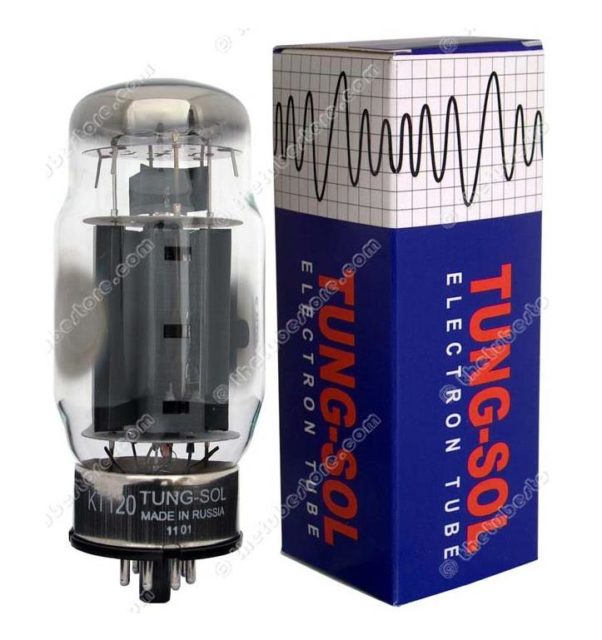 Tung-Sol KT120 (new production) on loan from Thetubestore.com ~$73 CDN each
Tung-Sol KT120 (new production) on loan from Thetubestore.com ~$73 CDN each
The Tung-Sol KT120 (and KT150) tubes are new designs, basically more powerful versions of KT88 and 6550 tubes. At the very least they draw more filament current than KT88s. The monster power transformer in the TU-8340VK is rated to supply the juice these tubes require. The Hammond transformers in my Eiclones should be up to the job too.
Eiclone Amp. Bias set to 75% of dissipation limit. At this dissipation the Hammond power transformers in these amps were running warm. But then all Hammonds run warm if not quite hot. The bass has great grip, drive and propulsion. The control over the woofers in both sets of speakers was impressive. In general the mids and highs seemed a bit laid back, compared to the KT77 tubes. The sound was very easy to listen to, the sound stage reasonably precise. Music seemed to just flow without sounding “hifi”. There was a rightness, a symbiosis, of this tube/amp combination.
Eiclone Amp. Bias set to 32% of dissipation limit (like Elekit). The sound qualities noted above were noticeably diluted. The bass lost some control, there was less precision with regards to placement in the sound stage and the mids and highs were less smooth.
Elekit Amp. Bias automatically set to 32% of dissipation limit. The bass was less distinct compared to the Eiclone at 75%. It was also not as deep and not as punchy when required. The mids took on a kind of shouty quality that was not appealing. The sound was noticeably less engaging overall.
Recommend if you have an amp that will give the KT120 the bias and therefore the current they need. With a cap swap in my Eiclones for something a bit brighter, and/or a bit of input tube rolling I’m sure I could get these closer to the sound of my Ref 110. But even as they are right now, the sound is darn nice and the best I’ve heard from my Eiclones.
If on the other hand your amp cannot support their bias and power requirements, I think you’d be wasting your money. At “standard” levels of bias the KT77 has much better performance for a bit less money than the KT120.
Full Summary
Eiclone Amp, Triangle Speakers. My favourite tube: Tung-Sol KT120, Close second: KT77
With the bias cranked to 11, actually 99 milliamps per tube, this combination is the real deal. The Hammond power transformer in each amp gets pretty warm, but not any warmer than the P.T. in my ARC Ref 110. This combo of amp and tube really grabbed the Triangles by the scruffs of their necks and made them behave. The more efficient Triangles had a seeming effortlessness to them with this much power available. See comments below for PSB speakers, they apply as well to this combination. Actually it’s a close contest between the KT120 and KT77 with this amp/speaker. Both tubes sounded really good.
Eiclone Amp, PSB Speakers. My favourite tube: Tung-Sol KT120
With the bias cranked to 11 this combination is a winner too. As far as spectral balance, compared to my ARC pair, the Aikido/Eiclone/KT120 combination nailed it! This combination was the closest I’ve ever heard any linestage/amp/tube get to my ARC duo driving the PSBs. The ARCs are smoother yet more detailed and dimensional especially in the upper mids and highs. The Ref 110 has better control of the woofers as well, but not by a lot at reasonable volumes. The KT120s might be slightly woollier in the high treble than the KT77s below but it’s a close run thing. This, for my listening tastes, is the magic tube for this amp/speaker combination.
If you think I’ve been seduced by a tube that, while not offering the ultimate in midrange verisimilitude, has great bass extension, control, pace and rhythm, as well as an inviting and detailed midrange along with reasonably detailed yet smooth and non-fatiguing high frequencies; you’d be absolutely correct. I’ve wanted to use verisimilitude in a sentence for a very long time.
Elekit Amp, Triangle Speakers. My favourite tube: Genalex Gold Lion KT77
The bias, as set by the Elekit, was at 70% of the KT77s maximum dissipation, right near my preferred sweet spot. The Aikido/Elekit/KT77 combination got darn close to the Aikido/Eiclone/KT120 combo described above but in some respects I think the KT77 was slightly better. There just seemed to be a bit more natural, slightly clearer quality especially in the upper mid and high frequencies. This could in part be due to the previously noted differences between the amps. The KT77, for my listening tastes, is the magic tube for this amp/speaker combination.
If you think I’ve been seduced by a tube that to me just hits it out of the park……you know the rest.
Elekit Amp, PSB Speakers: My favourite tube: Genalex Gold Lion KT77
The bias, as set by the Elekit, was at 70% of the KT77s maximum dissipation. With the Aikido/Elekit/KT77 the mids and highs were very musical. The bass was trying hard, and mostly succeeded, in keeping up. This is my favourite tube with this amp/speaker combo. Bear in mind this was with the quasi nasty load of my PSBs. Though not the most ideal combination, the KT77 made the best of it.
~~~~~~~~~~~~~~~~~~~~~~~~
The One That Got Away?
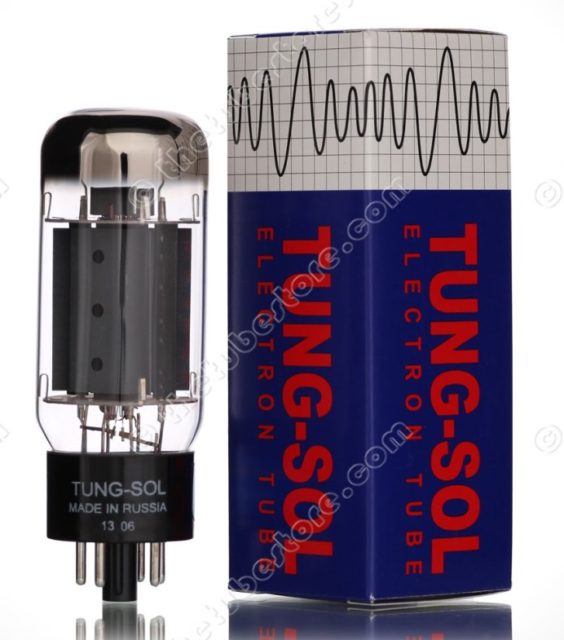 Tung-Sol 7581A (new production) ~$40 CDN each
Tung-Sol 7581A (new production) ~$40 CDN each
Tim Smith rated this tube highly in his 6L6 shootout. I’ve not heard it, but it could be a possibility in the Elekit. The price, though 50% more than the E-H EL34, isn’t that steep. This tube could be worth a shot.
Alternatively, if you have a buddy with a guitar amp that uses 6L6’s, or even possibly EL34’s, ask him, or her, if he/she has four spares. If he/she answers in the affirmative invite him/her over for a beer or glass of wine. Plunk their tubes into your amp, set the bias, and when they’ve warmed up for ten minutes or so spin some music. If you like what you hear, you might just have found your favourite tube. By that I mean, don’t rip-off your buddy, buy your own. Who knows, in the process you just might have made a convert to audiophilia. At worst you’ll have listened to some music, connected with your buddy and gotten a bit of a buzz. Just call your buddy a cab for the ride home or offer him/her the couch.
Big thanks to:
Jon at Thetubestore.com for the loan of the KT77 and KT120 tubes.
Victor Kung at vkmusic.ca for the loan of the Elekit TU-8340VK amp.


I’d agree with your findings, with the caveat that if you can use KT150’s they sound even better (fuller) than the KT120’s
I’d like to know if you’ve heard the Sophia Electric EL34’s?
Sorry Anthony, no I haven’t heard the Sophia EL34s. They are not available for loan from our good friends at Thetubestore.com and I was purposely trying to keep the cost of tubes surveyed to not much more than $50 US each. Thanks for your interest in Wall Of Sound.
Hi Steve, I have a question. I’m using 4 tung-sol 7581A tubes in my onix sp-3 integrated amp. The amp suggested a 1.15 volt bias setting, you mention a max dissipation limit. How do I know what the limit is and what percentage of that limit to set the bias.
Thank you, Mike
I’ve corresponded with Mike and tried to answer his questions. It got me thinking, not always a good thing, and in talking to the boss (Noam) I’m going to do an article on power tube biasing. I’ll start at the basics and hopefully not leave anyone behind. Watch this space!
All the best to WOS followers, Steve
I have been a musician for 50 yrs now and yes have played garbage and wonderful styles at loud levels when young. I am also a “had to be ET because on the road broken down equipment repair prices could be quite a problem. I would like opinions on quality versus durability in certain tube types and manufacturers. In my industry I have seem to find Russian tubes able to take brute force better than most. I have also, as it goes for the rock players class ab1 type amps, found that el34 types versus 6l6, or 5881, tubes give a warmer dare I say 3rd harmonic warmth to the guitarist overall sound. I guess what I am asking is do you pick any 1 brand as one that outlast or holds up better. Also does anyone still use the old 5881 tubes anymore. Just curious. Remember I am not dealing with many class A amps. Thanks.
Robbie:
I’m a little out of my depth when it comes to guitar amps. I’ve fixed and refurbished a few over the years but guitar players value different sonic qualities than audiophiles.
As far as reliability goes I find NOS tend to have more “issues” than new production tubes.
Many of the historic tube names (Genalex, Tung-Sol, Mullard etc.) have been bought up by New Sensor (newsensor.com) and all of these tubes along with others such as Sovtek are made in Russia. In my narrow experience I find the tubes made by New Sensor under the historic names tend to sound a bit better and be a bit more reliable, though they are more expensive.
The 5881 along with the 7581A were, back in the day, up-rated versions of the various 6L6 family of tubes. Whether this difference exists today or is just marketing hype is a good question.
Fellow WoS contributor Tim Smith rated the Tung-Sol reissue (Russian) 7581A highly in his 6L6 survey though this was in a hi-fi amp.
I think when it comes to guitar amp tubes I’ll have to refer you to someone like the people at thetubestore.com. They, I believe, do about as much business with guitar types as they do with audio weenies. Their knowledge base should be able to make specific recommendations.
Another resource could be the instruments forum on DIYaudio.com (http://www.diyaudio.com/forums/instruments-amps/)
Thanks for your interest in Wall Of Sound
Regards, Steve
I agree that the Tungsol KT 120s are “laid back” in the mids and the highs. A bit TOO laid back, and the soundstage lacks an accurate high frequency “airiness.” This makes soundstage placement a bit too vague. Using the Mercury Living Presence CD “The Nutcracker Suite” – which I’ve had for 30 years and heard on Jadis Defy 7, Goldmund Mimesi 9, VTL 300, VAC 70/70 and ASL Hurricanes – it is obvious the there is a lack of transparency as well. This might work well on non-classical music, but on this CD, which I’ve heard place the players correctly, it’s not a good match for the ARC Vsi60. Perhaps some other amps will show its qualities off better, but the ASLs create an astonishing realism no matter what tubes, and it is not apparent here. I notice the same lack of soundstage placement with Bill Evans at the Village Voice cd, with an obvious lack of low-level detail (the audience sounds are muted, and the ambience is, as well). And tonally, it is also good, but the colorfulness of a glockenspiel is not displayed as beautifully as it is in real life, or on Mercury, RCA or Decca Cds.
You WILL get a sense of space, overall, and reasonably good – but not great – transients, but not as good as with all the other amps mentioned. A nice tube, but I’m sure one needs to consider the type of music listened to (it is all too apparent with the Mercury catalogue, the RCA Living Stereo, and Decca CDs), but not everyone listens to unamplified classical music. A decent tube, but not great.